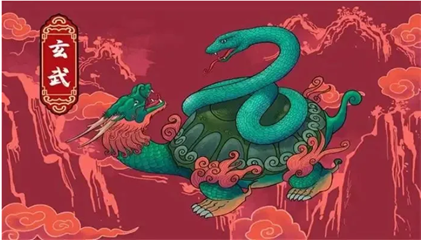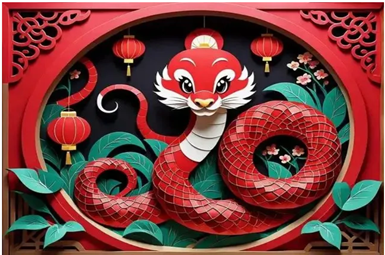2025 is the Year of Yisi (Year of the Snake). Snakes are closely related to the development of human civilization. Snakes can be seen in early civilizations around the world, symbolizing reproduction, spiritual power, authority, fierceness, etc, and their images are both positive and evil.
Thousands of years of snake charm: the multi-dimensional mark of snake in China culture
Snake culture in China has a long history. Fuxi and Nuwa, the ancestors of China, were humans on the upper body and snakes on the lower body, with their tails crossed, symbolizing reproduction. Guoyu records that the Zhou royal family came from Xuanwu, which was a combination of snakes and turtles. The snake was once one of the totems of the ancient tribes of China. The dragon was the body of the snake, and the snake was called the little dragon. In the twelve earthly branches or zodiac animals, the dragon and the snake are connected one after another. Zheng Xuan, a scholar in the Han Dynasty, believed that snakes and dragons belonged to the same category, and a dragon without horns was a snake. In ancient China, the dragon symbolized the king, and the snake symbolized the senior officials; the emperor wore the dragon robe, and the senior officials wore the python robe.

The images of snake immortals and snake demons appear in books such as Fantastic Creatures of the Mountains and Seas,In Search of the Supernatural,Journey to the West and Strange Tales from Liaozhai. However, the most famous one is Leifeng Pagoda in Yongzhen of the White Lady by Feng Menglong of the Ming Dynasty. It tells the story of the white snake banshee and the scholar Xu Xian meeting and falling in love at the West Lake in Hangzhou. However, the white snake demon was finally subdued by the monk Fahai and suppressed under the Leifeng Pagoda because it violated the rules of heaven. After continuous adaptation of operas, films and television, the story of the White Lady has become a household name in China and has become the cultural business card of Hangzhou West Lake. It was even displayed at the opening ceremony of the 2023 Hangzhou Asian Games.
There are also many legends about snakes repaying kindness in various parts of China, and snakes are regarded as spirit beasts in many places among the people. For example, in rural areas of northeastern China, snakes are called willow immortals. One of the twenty-eight constellations, the wing is a fire and a snake. It represents good fortune and can bless people's wealth.

Traditional Chinese medicine has long discovered the medicinal value of snakes. The Compendium of Materia Medica records the shapes and medicinal effects of 17 kinds of snakes. Liu Zongyuan's The Snake Catcher's Story records that the Tang Dynasty Imperial Hospital dried Yongzhou poisonous snakes to make medicines to cure diseases such as leprosy and sore, and even remove dead muscles and kill human parasites.
In addition, snakes also symbolize extraordinary vitality in China culture. The Art of War records that the snake of Changshan is very flexible and can look at each other from end to end, so it is used for reference in the art of war. Zhang Fei's weapon is a Eighteen-Span Viper Spear. The spearhead is flat, curved like a snake, and has blades on both sides, so it is called a Snake Spear. The Golden Snake Sword in Jin Yong's martial arts novel Crimson Sabre kills people in the light and is invincible. Li Bai's Cursive Script Songs compares the scene of Cao Sheng Huaisu writing quickly after being drunk to a dragon and snake walking with his pen, as if Chinese characters were free and unrestrained like snakes. The music Golden Snake Dance written by musician Nie Er in 1934 was so passionate that it was also used as background music for the opening and closing ceremonies of the 2008 Beijing Olympics.
The diversity of Korean snake culture: from blessings to disaster signs
In ancient Korea, snakes symbolized authority, immortality, fertility, and fertility. Seven days after Park Hyuk, the ancestor of Silla, ascended to heaven, his body fell from the sky and scattered to five places. The people of Silla wanted to collect the remains and bury them together, but were stopped by the snake, so they had to build five tombs, all of which were named Snake Mausoleum. Countless snakes gathered in the bedroom of King Jingwen of Silla every night. The palace people were very afraid and drove them away. However, King Jingwen said: If there were no snakes, I would not be able to sleep well, so don't drive them away.
When he was a boy, Xianzong of Koryo was hated by the Empress Dowager Qianqiu and was forced to cut his hair and become a monk. However, he wrote a poem saying,Don't look at a small snake under the flower forest, it will not be difficult to become a dragon in the future, to show his will. When Xu Jing, an envoy of the Northern Song Dynasty, was sent to Koryo, he once offered sacrifices at the Haku Dragon Temple in Wangjing. Unexpectedly, a small green snake walked out of the temple the next day. Everyone believed that it was a manifestation of a god. In ancient Korea, many places believed that snakes could communicate, and Jeju Island still maintained the custom of worshiping snake gods in courtyards outside houses to pray for the protection of family belongings.
However, snakes are also regarded as fierce and dangerous animals. During the Gaozong period of Goryeo, a snake as thick as a pillar was found crying in a cave on the northern border. People thought this represented disaster, and soon a rebellion broke out there. In 1436, a snake broke into Kangning Hall and occupied a document. Sejong of Korea believed that this represented a divine punishment, so he moved to Jinyang Dajun's house to avoid disaster. In 1769, a small snake broke into the ancestral temple during a sacrifice. Yingzu believed that this represented a disaster, but Hong Fenghan, the leader of the government affairs (an official position in ancient Korea, equivalent to a prime minister in China), pointed out that this was a natural phenomenon and there was no need to worry.
A well-known story of a snake man in South Korea is that of a young man hiding in the skin of a python, but the legend of the young man turning into a snake after his death is circulated in Qingpyong Temple in Chuncheon, Gangwon Province. It turned out that a young man loved Princess Pingyang of the Tang Dynasty, but was executed for it. So he transformed into a snake and clung to the princess's body. The princess could not get rid of it, so she could only come to Qingping Temple in Silla to seek Dharma from an eminent monk. In the end, she successfully separated from the snake and ended this evil relationship. There are still many related relics in Qingping Temple, and statues of the princess and the snake are carved.
Due to the medicinal value of snakes, many people in ancient South Korea made a living by catching snakes. In 1749, Yingzu stated that snakes, as objects of Korean land, were hunted and sacrificed every year to the royal palace. However, he couldn't bear to bear it, so he ordered them to be done every three years. During the Gaozong period, a woman named Song Zhishou in Jinzhou learned that her mother-in-law was seriously ill and only a flower snake could cure her. She prayed in the wild. Unexpectedly, a white snake really appeared and finally cured her mother-in-law.
Japanese snake culture: from legendary symbols to secular worship
The Nagi Serpent is a classic in Japanese legends. It is recorded in Gu Shi Ji and Nihon Shu Ji. It is said that it was killed by the great god Suzhan Naruto. According to some scholars, there are cultural similarities between Suzhan Mingzun's killing of the Bachi Snake and the stories of Da Yu in China who killed Xiangliu, Liu Bang, the Emperor of Han Dynasty, who killed the white snake, and Li Ji killed the snake in the Eastern Jin Dynasty. One of the three great artifacts of the Japanese royal family, the Kusanagi Sword (also known as the Sky Congee Cloud Sword), came from the tail of the Nagi Snake, which may indicate that the snake also had a symbol of power and force in early Japanese culture. Japanese shrines, Torii and other religious sites often hang straw ropes, and the ropes are wound around in the shape of a snake mating scene. Therefore, some people believe that this is related to snake worship, symbolizing union and reproduction.
Many areas in Japan have the custom of worshipping snakes, and the Iwakuni White Snake in Iwakuni City, Yamaguchi Prefecture is the most representative. The Iwakuni white snake is originally an albino species of the Japanese kosher snake. Due to its frequent appearance in the local area and the Iwakuni tradition of worshiping white snakes, relevant agencies artificially raise these white snakes to maintain their albino bloodline and increase the number of white snakes. As a unique snake species in Japan, the Iwakuni White Snake has been designated as a national natural monument by Japan.
In short, the snake cultures of China, South Korea and Japan are rich and colorful, reflecting the wisdom of our ancestors to get along with nature.
Author | Yu Xianlong, Deputy director and Assistant Research Professor of the Institute of the History of Global Civilizations at Shanghai International Studies University.
Source | People's China, No. 2, 2025.
Translated and reviewed by Chen Xinran with AI translator




